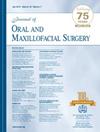What Factors Influence Success of Mandibular Reconstructions With Patient-Specific Selective Laser Melted Reconstruction Plates?
IF 2.6
3区 医学
Q2 DENTISTRY, ORAL SURGERY & MEDICINE
引用次数: 0
Abstract
Background
Patient-specific reconstruction is becoming more ubiquitous in craniomaxillofacial surgery. There is a paucity of information on what factors may influence case success.
Purpose
The purpose of the study was to estimate patient-specific hardware failure rate and to identify risk factors associated with hardware failure.
Study Design, Setting, Sample
A retrospective cohort study was implemented using data from subjects treated with selectively laser melted (SLM) reconstruction plates at the University of Iowa. Subjects were excluded if follow-up was less than 3 months, data were not complete, or the subjects were not treated with an SLM plate.
Predictor Variables
The predictor variables were composed of heterogenous variables grouped into the following categories: demographics, etiology, mandibular characteristics, and reconstruction plate characteristics, such as number of screws proximal and distal to fracture/defect.
Main Outcome Variable
The primary outcome variable was time to screw failure (yes/no), which was determined by examining subject radiographic data and if it was clinical reason for the removal of the reconstruction plate.
Covariates
The only covariate is sex.
Analyses
Descriptive statistics were calculated for each variable. Bivariate Cox regression analyses were performed to assess the association between each variable and the hazard of screw failure. Alpha = 0.05 was considered significant.
Results
The sample included 131 subjects. The median follow-up time was 11.0 (interquartile range 14.0) months. There was 1 (0.8%) plate fracture and 10 (7.6%) screw failures. Subjects with 1 additional screw proximal to the fracture/defect (eg, from 3 to 4, or 4 to 5, or 5 to 6) had a 63% higher hazard of screw failure at any given time over the follow-up period (hazard ratio [HR] = 1.63; P = .04; 95% CI, 1.02 to 2.63). Subjects with 1 additional screw distal to the fracture/defect had a 58% higher hazard of screw failure (HR = 1.58; P = .01; 95% CI, 1.10 to 2.26). Among patients with continuity defects (n = 49), those who received a bone graft had an 85% lower hazard of screw failure compared to those who did not receive a graft (HR = 0.15; P = .03; 95% CI, 0.03 to 0.851).
Conclusion and Relevance
SLM reconstruction plate fracture is rare. Adding additional screws proximal and distal to a fracture/defect may lead to a higher hazard of hardware failure. Using a bone graft for continuity defects may lead to a lower hazard of hardware failure.
影响患者选择性激光熔化重建板下颌重建成功的因素是什么?
背景:患者特异性重建在颅颌面外科手术中越来越普遍。关于哪些因素可能影响案件成功的信息很少。目的:本研究的目的是估计患者特定的硬体失败率,并确定与硬体失效相关的危险因素。研究设计、设置、样本:采用爱荷华大学选择性激光熔化(SLM)重建板治疗的受试者数据,实施回顾性队列研究。如果随访时间少于3个月、数据不完整或未接受SLM钢板治疗,则受试者被排除。预测变量:预测变量由异质性变量组成,分为以下几类:人口统计学、病因学、下颌特征和重建钢板特征,如骨折/缺损近端和远端螺钉数量。主要结局变量:主要结局变量是螺钉失效的时间(是/否),通过检查受试者的影像学资料和是否为取出重建钢板的临床原因来确定。协变量:唯一的协变量是性别。分析:对各变量进行描述性统计。采用双变量Cox回归分析来评估每个变量与螺钉失效危险之间的关系。Alpha = 0.05被认为是显著的。结果:共纳入131名受试者。中位随访时间为11.0个月(四分位数间差14.0个月)。钢板骨折1例(0.8%),螺钉断裂10例(7.6%)。在骨折/缺损近端增加1颗螺钉(例如,从3到4,或4到5,或5到6)的受试者在随访期间的任何给定时间内螺钉失效的风险增加63%(风险比[HR] = 1.63;P = .04;95% CI, 1.02 ~ 2.63)。在骨折/缺损远端增加1颗螺钉的受试者螺钉失效的风险高出58% (HR = 1.58;P = 0.01;95% CI, 1.10 - 2.26)。在连续性缺陷患者(n = 49)中,接受骨移植的患者螺钉失效的风险比未接受骨移植的患者低85% (HR = 0.15;P = .03;95% CI, 0.03 ~ 0.851)。结论及意义:SLM重建钢板骨折是罕见的。在骨折/缺损的近端和远端添加额外的螺钉可能会导致更高的硬件故障风险。使用骨移植物治疗连续性缺陷可能导致较低的硬件故障风险。
本文章由计算机程序翻译,如有差异,请以英文原文为准。
求助全文
约1分钟内获得全文
求助全文
来源期刊

Journal of Oral and Maxillofacial Surgery
医学-牙科与口腔外科
CiteScore
4.00
自引率
5.30%
发文量
0
审稿时长
41 days
期刊介绍:
This monthly journal offers comprehensive coverage of new techniques, important developments and innovative ideas in oral and maxillofacial surgery. Practice-applicable articles help develop the methods used to handle dentoalveolar surgery, facial injuries and deformities, TMJ disorders, oral cancer, jaw reconstruction, anesthesia and analgesia. The journal also includes specifics on new instruments and diagnostic equipment and modern therapeutic drugs and devices. Journal of Oral and Maxillofacial Surgery is recommended for first or priority subscription by the Dental Section of the Medical Library Association.
 求助内容:
求助内容: 应助结果提醒方式:
应助结果提醒方式:


